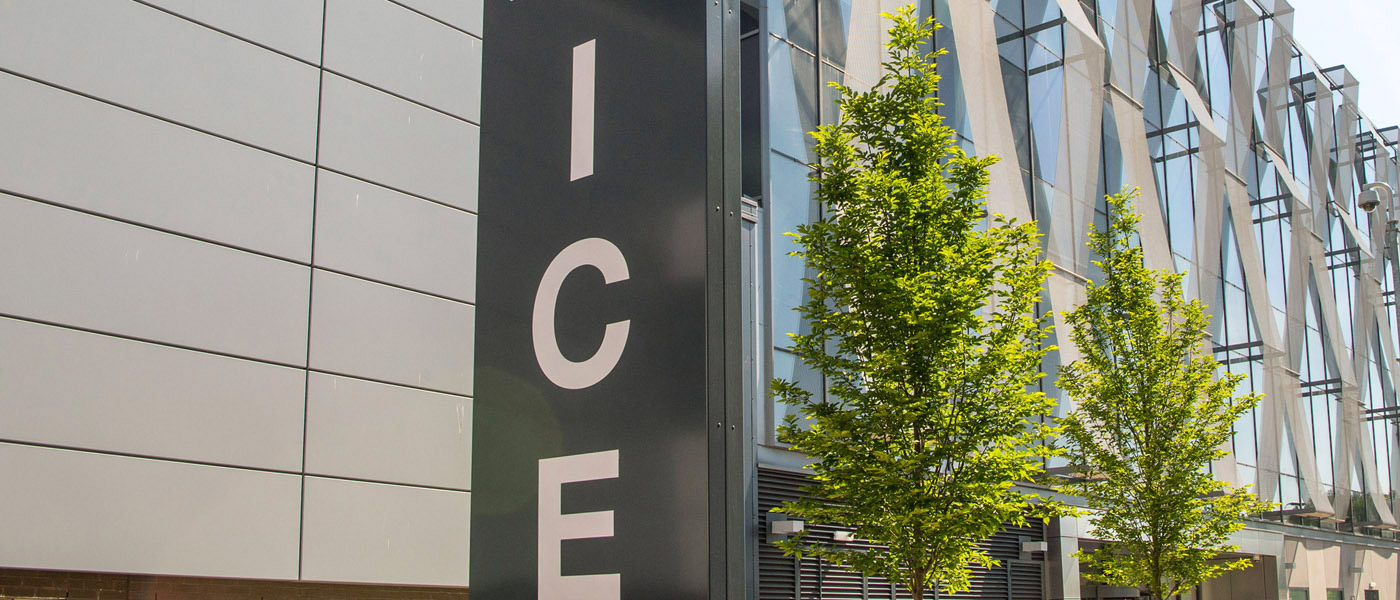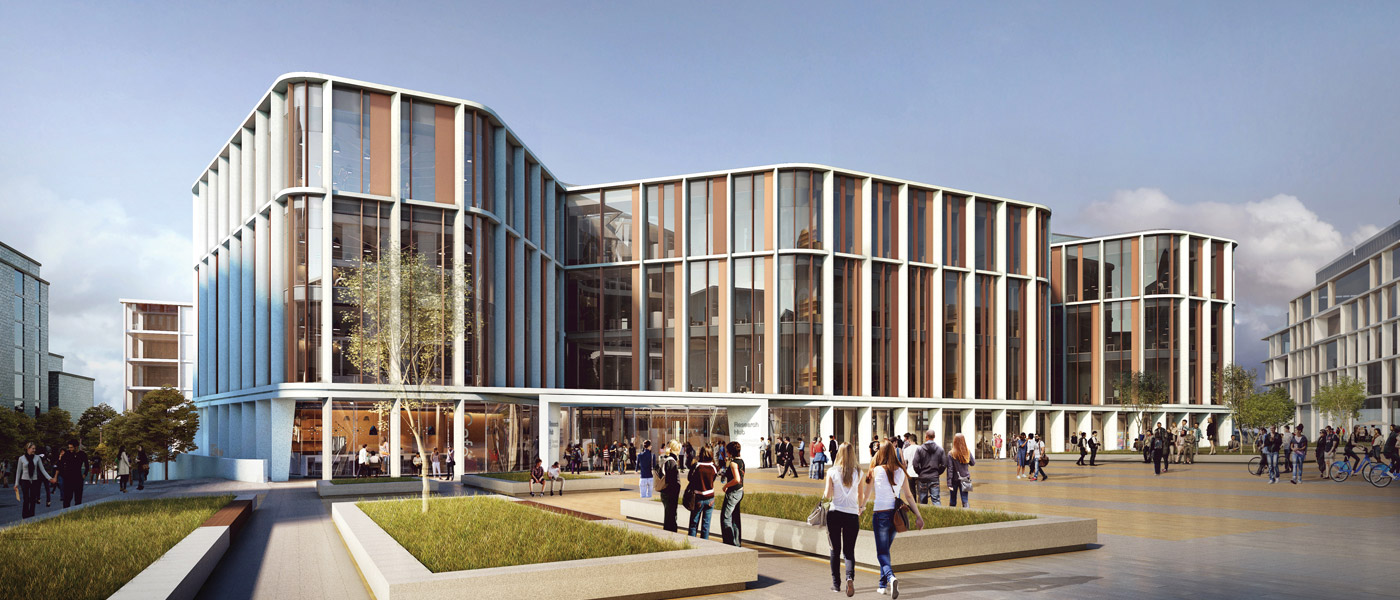Connectivity
 Collaboratively minded, digitally enhanced
Collaboratively minded, digitally enhanced
Creativity feeds on stimulation. Ideas improve when students and colleagues work together, challenge their assumptions and inspire one another with fresh insights and approaches. We want to make Glasgow a nexus of collaboration and innovation - a first-class physical and digital environment that brings people together whenever and wherever inspiration strikes.
Creating space to connect through new collaborative and social space on campus
We will:
- expand our social space provision to make campus a welcome home away from home
- create an ecosystem of collaborative spaces on campus, including touchdown hubs to facilitate agile working and spaces for short-term collaborative projects
- develop facilities on campus for externally facing partnership activities including start-ups, spinouts, and co-location of corporate partners
- broaden public access to and use of our campus locations and assets.
Tackling the global water challenge
Some 35% of the world's population, most of whom live in rural communities, lack access to either improved sanitation or safe drinking water. The western, centralised model for water supply and treatment is too energy- and capital-intensive to deliver sustainable solutions in these countries.
Professor of Environmental Engineering Bill Sloan and his team will harness the bioprocessing power of microorganisms to deliver clean drinking water and treat wastewater in rural communities using low-energy, sustainable, off-grid technologies.

“I have spent much of my career to date researching the fundamentals of engineering biology in water systems,” he says. “A suite of emerging technologies now presents me with the opportunity of applying the knowledge I have gained in new ways that will help to deliver clean water and sanitation to rural communities. We intend to work in collaboration with global partners to develop new off-grid water technologies for remote communities from the Scottish islands to tropical rainforests.”
Working from the Advanced Research Centre will ensure Bill and his team have proximity to a range of disciplines which will help him achieve this ambitious goal. The team will be working with biomedical engineers who have developed low-cost point-of-use sensors to monitor the biology and chemistry of distributed off-grid water biotechnologies, and with chemists applying ideas from digital chemistry to bioremediation. They will collaborate with social and political scientists through demonstrators and workshops to explore responsible and acceptable solutions.
“The goal,” says Professor Sloan, “is a co-located cohort of academics, business development professionals, and research and development facilities, that will have international reach.”
Clinical Innovation Zone: a unique space
The University has created innovation and interaction spaces as part of a series of major investments at the Queen Elizabeth University Hospital, to improve the health of people in Scotland and bring innovation and growth to Glasgow.
The Clinical Innovation Zone (CIZ) is a unique space where industry, academia and the NHS work alongside each other on precision medicine projects.

The CIZ is a key asset of the Glasgow Riverside Innovation District and provides 22,000 square foot of high-specification units designed to foster open innovation and provide tenants with access to world-leading clinical academics, outstanding clinical research facilities and industry partners.
A £32m investment in a world-leading Imaging Centre of Excellence within CIZ offers greatly enhanced medical imaging technology, such as an ultra-high-resolution 7 Tesla MRI scanner, the first of its kind to be fully integrated within a clinical site in the UK. The centre enables corporate partners including Thermo-Fisher, CANON and Siemens, and high-growth small and medium sized enterprises including BioClavis and Causeway Therapeutics to use state-of-the-art imaging equipment in a clinical setting, working alongside academic experts.
Find out more
Investing in our digital realm to enhance the staff and student experience
We will:
- upgrade our digital systems and services to create higher quality user experiences
- expand our network to offer pervasive connectivity across our campuses
- roll out smart campus technologies to create an empowering and user-responsive environment.
The ARC, enabling greater connectivity
The ARC, the Advanced Research Centre, will be the creative and collaborative heart of research at UofG. The £113m building will help bridge the boundaries between research, cross-subject collaboration and true societal impact.
The ARC, which will open in spring 2022, will provide a space where world-changing research can thrive. Work is underway to deliver advanced digital technology within the new building to support the vision and aspirations of the ARC and allow greater connectivity between researchers.
The ARC will invest in advanced IT systems to support collaboration and ensure researchers and visitors have access to state-of-art audio-visual and networking facilities for building connections and engaging with other research groups.

The IT systems within the ARC will enable academic staff, students and visitors to move around the building by providing docking stations for laptops and MacBooks instead of static PCs. Public spaces such as the exhibition and meeting areas will also be fitted with similar technology and will support wireless interaction, including provision for guest users.
This Agile IT approach will ensure the space is flexible for a wide variety of users and will encourage collaboration between groups who may not have interacted without these facilities.
The ARC will feature cutting-edge audio-visual equipment to support the delivery of events, meetings and engagement activities for all users.
The new building will also house one of the largest virtual reality (VR) suites in the UK. This unique facility, with the provision to feed video into meeting rooms or adjacent public areas, will advance understanding about how VR can be incorporated into research and teaching activities.
Martin Munro, Senior Project Development Manager of the Research Hub Project Delivery Board, explains: “The digital environment within the ARC will provide an agile IT ecosystem to enable research across many different disciplines and allow our researchers to work without barriers.”
Find out more
5G is making our campus smarter
A common thread running through 2020 has been our increased use of and reliance on new technology for working and learning.

We have all had to adapt quickly to this new way of living and working, but being forced to suddenly embrace smart technologies may be no bad thing. It’s preparing us for something even more powerful on the horizon, 5G, a massive breakthrough that will revolutionise the experience of all of us.
5G is the newest and most advanced global wireless technology standard. It uses ultra-high-frequency radio waves to increase the speed of connection and will allow communications up to 250 times faster than its predecessor 4G and be far more reliable.
"5G will transform many aspects of our lives. Professor Muhammad Imran
Muhammad Imran is Professor of Communications Systems at Glasgow. He is clear about the benefits that 5G will bring. “Connectivity is vital at the present time,” he says, “and 5G will take that one step further in future. It has immense potential, for example, to extend the connectivity from human-to-human to human-to-machines and machine-to-machine. It will also transform many aspects of our lives such as education, healthcare, shopping, governance and security.”
At Glasgow, we are embracing this new technology and making 5G a reality for the University community. According to Professor Imran UofG is one of the leading developers of 5G technology both in Scotland and worldwide. Our 5G centre at the James Watt School of Engineering contains an experimental network providing indoor and outdoor coverage across campus, which is helping researchers and commercial companies to trial new-use cases and applications of 5G.
Some of the innovative applications that these groundbreaking smart technologies will have on campus include
- teaching and learning: using special virtual reality technology, students will be able to watch operations or visit “clean rooms” remotely, changing their perspective individually
- remote work and labs access: using low latency and high bandwidth communication and remotely controlled robotic arm, students and staff will be able to access labs and physical work remotely. Participants of the meetings will have a more immersive experience by using the holographic tele-presence technology operating on the 5G network.
- crowd management: live messages will be relayed to students moving around campus to tell them where they can avoid congested pathways or staircases
- building management: estate managers will be able to see remotely which areas on campus are being utilised more than others, where energy efficiency is low, and make instant adjustments. Users of agile desk space will know where space is available before visiting a specific building.
- smart parking: live alerts will tell drivers where there are free spaces on campus, suggesting diversions and alternatives to their usual parking spots
- site tours to remote locations: an instructor can talk to students remotely, relaying information through their smart glasses, while walking them through a location
- tourism on campus: visitors wearing virtual reality glasses can have information instantly superimposed on their view, for example, historic images of the building they are passing.
Find out more
Adopting collaborative technologies for frictionless and flexible work and study
We will:
- equip staff for agile working wherever feasible to increase effectiveness, employee satisfaction and work-life balance
- augment and enhance our digital learning tools and resources to empower students with freedom of when, where and how they learn
- make it easier to connect and collaborate virtually with the international academic community, our networks, and our external partners.
PGR@Home supports researchers’ lockdown needs
PGR@Home was an innovative open-access response to the pandemic that provided support to early career researchers with a structured programme of personal and professional development.
PGR@Home was developed and launched in summer 2020 in response to the pandemic, when many PGRs and postdocs were feeling anxious about their future and operating in often isolated, lonely and make-shift conditions. The aim was to provide online support in the form of bite-sized opportunities for PGR personal and professional development, and to introduce PGRs to key UofG staff and resources that can help them on their research journeys, as well as engendering a research community even under lockdown conditions.

This was a truly cross-university effort, with contributions from staff and current PGRs, from several services (including the Library and IT) and schools.
This project is all the more impressive as it was led by Joanna Royle, Researcher Development Adviser, who only stepped into post in the first few days of lockdown. She still hasn’t made it into the office but somehow managed to build, lead and inspire a cross-university team to deliver PGR@Home in an entirely new and creative format.
PGR@Home ran for three months from April to June 2020. Launched with an introductory video, it supported PGRs with asynchronous and synchronous weekly content on topics as diverse as writing a literature review through to presenting at online conferences. Each week there was a website-hosted package of materials filled with information, videos, downloadable resources, links and activities. Then bringing researchers together each Friday, the key delivery partners held a drop-in 'chat cafe' to share experiences and answer questions.
The impact of PGR@Home has been well recognised; both by the sector and by researchers. The website regularly had 200 hits a day (and has had over 5,000 total visits) and the feedback has been fantastic.
PGR@Home was designed with thoughtful consideration of researchers' needs under lockdown. Those with caring responsibilities or those struggling with their mental health were able to participate when it suited them.
Many of the lessons from PGR@Home have now been shared with the graduate schools to form the basis of our ongoing support for PGRs and will continue to influence the research culture at UofG.
SOCIAL AI, training the next generation of experts
SOCIAL AI is a Centre for Doctoral Training (CDT) in Socially Intelligent Artificial Agents. Funded by UK Research & Innovation (UKRI) SOCIAL is a multidisciplinary, collaborative centre with 16 industrial partners.
To fully realise the potential of artificial intelligence (AI) it is imperative that humans and artificial agents can understand each other and work together effectively. The SOCIAL AI CDT builds on the world-leading, artificial intelligence research undertaken at Glasgow, focusing on endowing artificial agents with social intelligence. The ability to deal appropriately with users’ attitudes intentions, feelings, personality and expectation.
Over the course of eight years the centre will train a total of 50 PhD students. Research will be developed in collaboration with industry partners to address real-world industry problems.
Professor Stacy Marsella, Co-Director of SOCIAL, reinforces the importance of collaboration. “To broaden the positive impact of AI on society, we need AI systems that can effectively interact with us,” he says. “This will require a transdisciplinary effort across computer and psychology/social sciences. The goal of the SOCIAL AI CDT is to train the next generation of researcher capable of bridging this disciplinary divide.”
The SOCIAL AI CDT will be taking space in the ARC, the University’s Advanced Research Centre, when it opens in Spring 2022.
ARC will provide a space for researchers and students from the SOCIAL AI CDT to connect with potential collaborators from across the University, as well as providing easier access to complimentary research disciplines housed within the building.
Professor Alessandro Vinciarelli, research overview
“I am very excited that we will have a base in the ARC,” says Professor Alessandro Vinciarelli, Director of SOCIAL AI. “It will provide us with flexible space to advance AI research and to test interactive systems. The proximity to the virtual reality suite will be hugely beneficial to our research and our students.”
Dr Monika Harvey, Co-Director of SOCIAL, adds “Having space in the ARC will increase the visibility of our SOCIAL AI CDT, providing opportunities for us to connect with the wider University community, learn from other disciplines, share ideas and be creative.”

